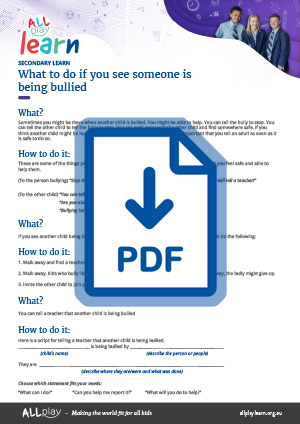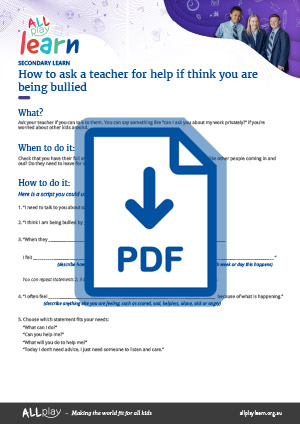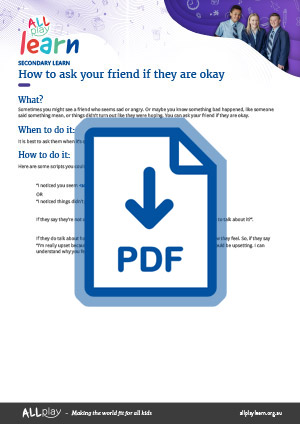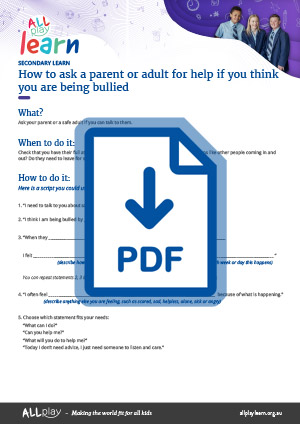
Teacher Guide to
Bullying and
Exclusion
Refer to your school’s Student Engagement Policy
All schools are expected to have a Student Engagement Policy to prevent and respond to bullying or other forms of unacceptable behaviour. This policy will include whole school strategies and initiatives as outlined in the Victorian Department of Education’s anti-bullying policy. Your engagement and support of this policy can help create an inclusive environment for students with a disability.Talk regularly with students about inclusion
Consider ways in which you can promote tolerance in your classroom. Talk to students about diversity and the ways in which individual differences can be valued. Consider having different guests/videos which cover different disabilities, and highlight positive contributions made by people with disabilities. Talk about language, including why we should avoid terms that may be offensive to another student. Focus on the strengths and positive attributes of people/students with disabilities. If a student and their family wish to disclose a student’s disability to peers, consider accessing AllPlay Learn’s disclosing a disability page which includes information about how to talk with peers about a disability, or AllPlay Learn’s Information Sheets for Peers in the teacher resources page.Talk to students about your school’s bullying policy
Talk to students about what bullying is (and isn’t!), what exclusion is, and clearly outline for them what inclusion and positive behaviour looks like at school. Provide clear expectations to students about what is expected of them, and what is not tolerated at school. You may also want to complete an activity with students in which they create a group agreement or guidelines as to what inclusion and positive social behaviour will look like in their classroom and school.Teach students social and emotion regulation skills
Consider teaching students positive social skills that they can use to develop friendships or handle conflict (see AllPlay Learn’s social skills page). Teaching all students how to recognise emotions and express these in a positive way can also help reduce conflict and increase inclusion (see AllPlay Learn’s emotions page). It may also be important to talk to students about how they should respond when being bullied or when they see someone else being bullied, and how they can seek help. Access AllPlay’s secondary stories on What is bullying and what to do about it; What is bullying and what to do about it - simple version; What is Cyberbullying; and seeking help.Consider ways in which your classroom and school can support a student’s inclusion
Identify the situations or contexts in which exclusion may happen (e.g. lunchtimes, group activities). For example, lunchtimes may be particularly challenging for students who are unsure how to join in with others. Strategies that may help include a peer buddy system for the earlier stages of the school year, teaching students how to invite new students (or students who are alone) to join them, and running diverse lunchtime programs such as games on the oval, chess club, or choir, particularly if these are linked to a student’s interests.Learn how to recognise the signs that a student may be experiencing bullying or exclusion
If a student’s behaviour or emotions change significantly, this can sometimes be an indicator they are being bullied or excluded. There can also be many other possible explanations for changes in behaviour and emotions. If you observe some of the following indicators, consider talking with the student directly or observing peer interactions and relationships over a number of days.
- Often alone or excluded.
- Frequent target for teasing, mimicking or ridicule.
- Stops/reduces speaking up in class.
- Changes in their emotions – frequent tears, anger/aggression, mood swings, anxiety.
- Appearing anxious/insecure.
- Appearing withdrawn or depressed.
- School refusal or avoidance.
- Frequently complaining of headaches or stomach upset (mostly connected to school attendance).
- Physical injuries (bruises/scratches) with no explanation.

- Changes in their academic performance at school.
- Missing or damaged belongings.
- Changes in their behavior (including aggression/bullying behavior towards other children).
- Talking about having no friends or being disliked by other students, or of self-harm/death.
- Refuse to talk about what is wrong.
- Appear anxious or insecure.
- Difficulty concentrating.

Bullying Scripts
- Students can use the scripts below to practise asking for help, if they ever need it.





